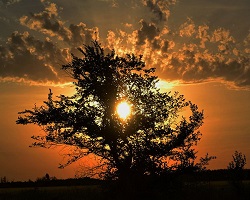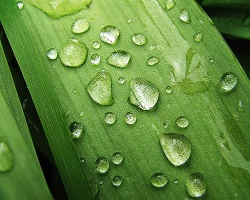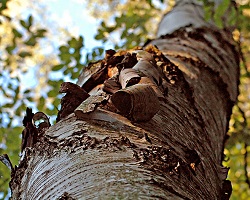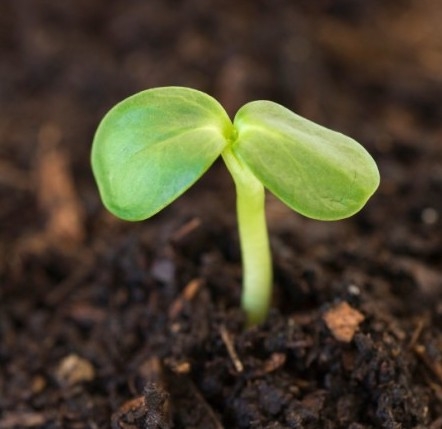show/hide words to know
In with One Energy and out with Another
The light-dependent reactions take place in the thylakoid membrane, inside chloroplasts. Since they are light 'dependent' reactions, you can guess that these reactions need light to work. Remember that the purpose of this first part of photosynthesis is to convert sunlight energy into other forms of energy?

The light-dependent reactions of photosynthesis require sunlight. Image by Mell27.
Plants cannot use light energy directly to make sugars. Instead, the plant changes the light energy into a form it can use: chemical energy. Chemical energy is all around us. For example, cars need the chemical energy from gasoline to run. The chemical energy that plants use are stored in ATP and NADPH. ATP and NADPH are two kinds of energy-carrying molecules. These two molecules are not only in plants, as animals use them as well.
A Recipe for Energy
Plants need water to make NADPH. This water is broken apart to release electrons (negatively charged subatomic particles). When water is broken it also creates oxygen, a gas that we all breathe.
The electrons must travel through special proteins stuck in the thylakoid membrane. They go through the first special protein (the photosystem II protein) and down the electron transport chain. Then they pass through a second special protein (photosystem I protein).
Photosystem I and Photosystem II
Wait a second... first electrons go through the second photosystem and second they go through the first? That seems really confusing. Why would they name the photosystems that way?

Water molecules are broken down to release electrons. These electrons then move down a gradient, storing energy in ATP in the process. Image by Jina Lee.
Photosystem I and II don't align with the route electrons take through the transport chain because they weren't discovered in that order.
Photosystem I was discovered first. Later, photosystem II was discovered and found to be earlier in the electron transport chain. But it was too late, the name stuck. Electrons first travel through photosystem II and then photosystem I.
The Electron Transport Chain
While at photosystem II and I, the electrons gather energy from sunlight. How do they do that? Chlorophyll, which is present in the photosystems, soaks up light energy. The energized electrons are then used to make NADPH.
The electron transport chain is a series of molecules that accept or donate electrons easily. By moving step-by-step through these, electrons are moved in a specific direction across a membrane. The movement of hydrogen ions are coupled with this. This means that when electrons are moved, hydrogen ions move too.
ATP is created when hydrogen ions are pumped into the inner space (lumen) of the thylakoid. Hydrogen ions have a positive charge. Like in magnets, the same charges repel, so the hydrogen ions want to get away from each other. They escape the thylakoid through a membrane protein called ATP synthase. By moving through the protein they give it power, like water moving through a dam. When hydrogen ions move through the protein and down the electron transport chain, ATP is created. This is how plants turn to sunlight into chemical energy that they can use.
The Calvin Cycle: Building Life from Thin Air
How does something like air become the wood of a tree? The answer lies in what makes up the air.

How can the air surrounding a tree be turned into tree material? Through a complex set of reactions that use the carbon from the air to make other materials. Image by André Karwath.
The air holds different elements like oxygen, carbon, and nitrogen. These elements make up molecules like carbon dioxide (CO2). Carbon dioxide is made out of one carbon atom and two oxygen atoms. Plants take the carbon atom from carbon dioxide and use it to build sugars.
This is done using the Calvin cycle. The Calvin cycle occurs inside chloroplasts, but outside the thylakoids (where ATP was created). The ATP and NADPH from the light-dependent reactions are used in the Calvin cycle.
Parts of the Calvin cycle are sometimes called light-independent reactions. But don't let the name fool you... those reactions do require sunlight to work.
The protein RuBisCO also helps in the process to change carbon from the air into sugars. RuBisCO works slowly, so plants need a lot of it. In fact, RuBisCO is the most abundant protein in the world!
The products of the Calvin cycle are used to make the simple sugar glucose. Glucose is used to build more complex sugars like starch and cellulose. Starch stores energy for the plant and cellulose is the stuff of which plants are made.
Images via Wikimedia Commons. Seedling image by Bff.
View Citation

Plants need chemical energy to grow and survive. But how do they convert energy in sunlight into chemical energy?
Be Part of
Ask A Biologist
By volunteering, or simply sending us feedback on the site. Scientists, teachers, writers, illustrators, and translators are all important to the program. If you are interested in helping with the website we have a Volunteers page to get the process started.







